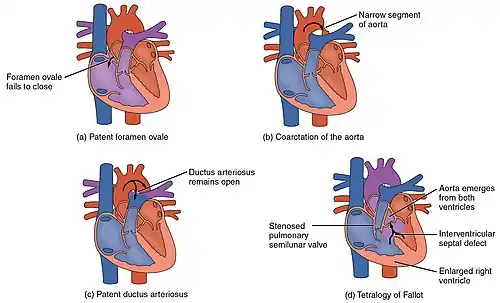| McDonough syndrome | |
|---|---|
| Other names | Mental retardation, peculiar facies, kyphoscoliosis, diastasis recti, cryptorchidism, and congenital heart defect |
 | |
| Specialty | Medical genetics |
| Symptoms | facial dysmorphisms, psychomotor delays, intellectual disabilities, and congenital heart defects |
| Usual onset | Conception |
| Duration | Lifelong |
| Prevention | none |
| Prognosis | Ok |
| Frequency | very rare, only 6 cases from three families in the U.S., Spain and India have been described in medical literature |
| Deaths | - |
McDonough syndrome, also known as Mental retardation, peculiar facies, kyphoscoliosis, diastasis recti, cryptorchidism, and congenital heart defect is a very rare multi-systemic genetic disorder which is characterized by facial dysmorphisms, psychomotor delays, intellectual disabilities, and congenital heart defects. Additional findings include either pectus excavatum or pectus carinatum, kyphoscoliosis, diastasis recti and cryptorchidism.[1]
Signs and symptoms
The following is a list of the symptoms individuals with this disorder usually exhibit:[2]
- Superciliary arc prominence
- Unibrow (clinically known as synophrys)
- Strabismus
- Large ears with anteversion
- Large nose
- Teeth malocclusion
- Psychomotor delay
- Intellectual disabilities
- Pulmonic stenosis
- Patent ductus arteriosus
- Atrial septal defect
Less common symptoms include chest defects, kyphoscoliosis, diastasis recti ane cryptorchidism
Cases
6 cases have been reported in medical literature:
- Gerhard Neuhäuser and John M. Opitz describes 3 out of 5 siblings from a 2-generation non-consanguineous family from Wisconsin with the symptoms mentioned above. These kids had IQs ranging from 47 to 67, which is considered clinical mental retardation. The youngest affected sibling had two X chromosomes and one Y chromosome and his father had te mosaic version of said disorder (46,XY/47,XXY). 1975[3]
- Garcia-Sagredo et al. describes 2 out of 3 siblings from a Spanish family. They had both the symptoms and the additional findings listed above in the article. One (male) of the children and his unaffected mother carried a balanced translocation on the 20th chromosome and the X chromosome. 1984[4]
- Parul Jain, Ritu Arora, Abhilasha Sanoria, Akshay K Singh described 1 out of 3 siblings from a 2-generation family from New Delhi, India: an 11 year old boy with the symptoms mentioned above and blepharoptosis with low visual acuity. 2022[5]
References
- ↑ RESERVED, INSERM US14-- ALL RIGHTS. "Orphanet: McDonough syndrome". www.orpha.net. Retrieved 2022-06-13.
{{cite web}}: CS1 maint: numeric names: authors list (link) - ↑ "McDonough syndrome - About the Disease - Genetic and Rare Diseases Information Center". rarediseases.info.nih.gov. Retrieved 2022-06-13.
- ↑ Neuhäuser, G.; Opitz, J. M. (1975-11-13). "Studies of malformation syndromes in man XXXX: multiple congenital anomalies/mental retardation syndrome or variant familial developmental pattern; differential diagnosis and description of the McDonough syndrome (with XXY son from XY/XXY father)". Zeitschrift für Kinderheilkunde. 120 (4): 231–242. doi:10.1007/BF00440262. ISSN 0044-2917. PMID 1189520. S2CID 31255769.
- ↑ García-Sagredo, J. M.; Lozano, C.; Ferrando, P.; San Román, C. (August 1984). "Mentally retarded siblings with congenital heart defect, peculiar facies and cryptorchidism in the male: possible McDonough syndrome with coincidental (X; 20) translocation". Clinical Genetics. 26 (2): 117–124. doi:10.1111/j.1399-0004.1984.tb00800.x. ISSN 0009-9163. PMID 6147215. S2CID 44263038.
- ↑ Jain. "Bowman's membrane corneal dystrophy in a case of McDonough syndrome: A new association". ijoreports.in. Retrieved 2022-06-13.
This article is issued from Wikipedia. The text is licensed under Creative Commons - Attribution - Sharealike. Additional terms may apply for the media files.